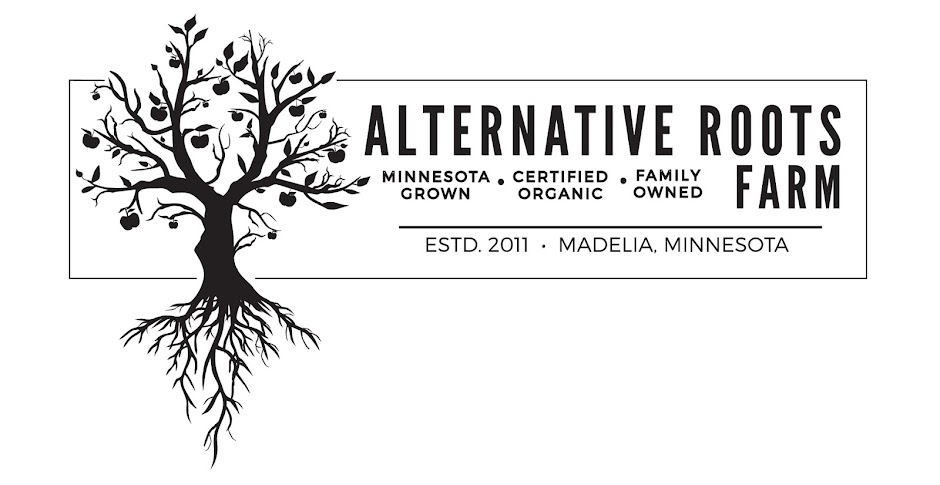 |
| Preparing for market with shallots and heirloom flint corn. |
"One key factor in the variety’s delicious flavor, Van Eeckhout told me, was that the corn was freshly ground. But even more importantly, it was ground whole. Most commercial cornmeal is made from yellow dent corn, or field corn, which has much tougher outer hulls on each kernel than the sweet corn we eat as a vegetable. Those fiber-rich outer hulls and the protein- and fat-rich core of each kernel—called the germ—are removed before grinding, robbing the cornmeal of nutrients—and flavor. Mandan Bride ears contain a combination of flint kernels (which are enclosed in hard shells) and flour kernels (made entirely of soft starch), adding interest and substance."
We trialed three different varieties of flint corn in 2013--Bloody Butcher, Roy's Calais and Mandan Bride. The very tall stand pictured is Bloody Butcher, which performed poorly at our site and we are not interested in trying again at this time. On the right is the Mandan Bride, which we were very happy with.
"It’s also, according to Van Eeckhout, “a real pain in the butt” to grow...weak stalks tip over before the corn has dried...So it must be picked by hand—never mind the laborious process of shucking, drying, and grinding."
The process of harvesting and processing this corn was indeed rewarding. It's nice that the harvest comes all at one time in the fall. John and I enjoyed walking through the rows, catching up in the evenings oohing and awing over the brilliant colors as we picked.
"All this corn was shucked while watching Sons of Anarchy or Breaking Bad." John wrote on a card accompanying a Christmas gift of flint corn to a friend. Netflix has indeed been a helper during such shucking and sorting exercises.
We may grown some flint corn for 2014, on a smaller scale, but we have to be conscious about the rotation, as corn is hard on the soil and our space is limited.
One of the benefits of being small, independent, and organic (in transition to organic certification) is that we get to choose what we grow, we get to experiment and trial unique items. Last year also ended up being a great year to grow this corn, as we were surrounded by a sea of soybeans, not corn.
A customer stopped by yesterday at market and commented, just as the author in that article, that her polenta was exceptional and she really enjoyed it. We haven't tried making polenta at home yet, simply cornmeal muffins and pancakes, but it's on the list of new things to try!
Alternative Roots Farm will be at the New Ulm Community Market and Cooperative's indoor market again on March 8th, 9am-1pm. Stop by and pick up some flint corn, it may be your last chance in 2014!
 |
| 2013 flint corn stand |
"It’s also, according to Van Eeckhout, “a real pain in the butt” to grow...weak stalks tip over before the corn has dried...So it must be picked by hand—never mind the laborious process of shucking, drying, and grinding."
The process of harvesting and processing this corn was indeed rewarding. It's nice that the harvest comes all at one time in the fall. John and I enjoyed walking through the rows, catching up in the evenings oohing and awing over the brilliant colors as we picked.
"All this corn was shucked while watching Sons of Anarchy or Breaking Bad." John wrote on a card accompanying a Christmas gift of flint corn to a friend. Netflix has indeed been a helper during such shucking and sorting exercises.
We may grown some flint corn for 2014, on a smaller scale, but we have to be conscious about the rotation, as corn is hard on the soil and our space is limited.
 |
| John holding an array of flint corn cobs. |
A customer stopped by yesterday at market and commented, just as the author in that article, that her polenta was exceptional and she really enjoyed it. We haven't tried making polenta at home yet, simply cornmeal muffins and pancakes, but it's on the list of new things to try!
Alternative Roots Farm will be at the New Ulm Community Market and Cooperative's indoor market again on March 8th, 9am-1pm. Stop by and pick up some flint corn, it may be your last chance in 2014!
 |
| Brooke at market, with Megan Burris, owner of Imbue Botanicals. Photo courtesy of Megan. |
:: The Latest from {Alt.Roots} ::
• Newest Farm Newsletter: February Farm News •
• CSA Shares still available :: Full Shares, Half Shares, Monday & Wednesday delivery •
• Farm Shares still available :: 3 remaining, $100 or $150 amounts •
Call or email to reserve a share!
• Why Heirloom? •
Quotes from The Search for Mandan Bride, Minnesota Monthly, Nov. 2006




